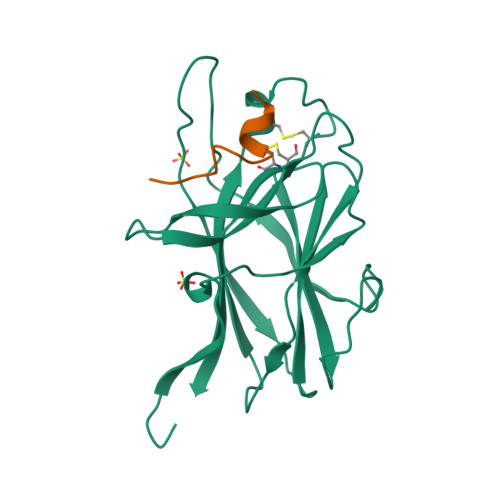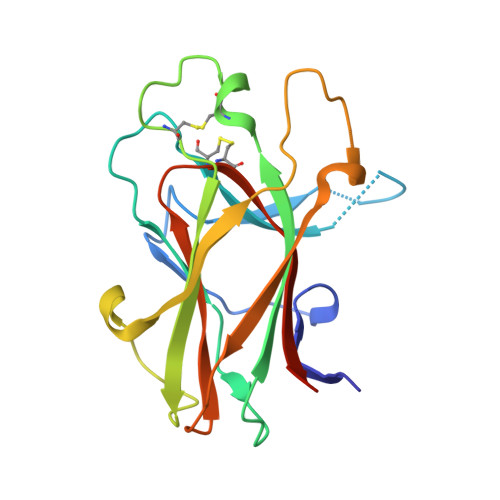EPH receptor B4
Target not currently curated in GtoImmuPdb
Target id: 1833
Nomenclature: EPH receptor B4
Abbreviated Name: EphB4
Contents:
Gene and Protein Information  |
||||||
| Species | TM | AA | Chromosomal Location | Gene Symbol | Gene Name | Reference |
| Human | 1 | 987 | 7q22.1 | EPHB4 | EPH receptor B4 | |
| Mouse | 1 | 987 | 5 G2 | Ephb4 | Eph receptor B4 | |
Previous and Unofficial Names  |
| HTK | Tyro11 | Hepatoma transmembrane kinase | Developmental kinase 2 | Ephrin type-B receptor 4 | Tyrosine kinase MYK-1 | MDK2 |
Database Links  |
|
| Alphafold | P54760 (Hs), P54761 (Mm) |
| BRENDA | 2.7.10.1 |
| CATH/Gene3D | 2.60.120.260, 2.60.40.10 |
| ChEMBL Target | CHEMBL5147 (Hs), CHEMBL4739680 (Mm) |
| Ensembl Gene | ENSG00000196411 (Hs), ENSMUSG00000029710 (Mm) |
| Entrez Gene | 2050 (Hs), 13846 (Mm) |
| Human Protein Atlas | ENSG00000196411 (Hs) |
| KEGG Enzyme | 2.7.10.1 |
| KEGG Gene | hsa:2050 (Hs), mmu:13846 (Mm) |
| OMIM | 600011 (Hs) |
| Pharos | P54760 (Hs) |
| RefSeq Nucleotide | NM_004444 (Hs), NM_001159571 (Mm) |
| RefSeq Protein | NP_004435 (Hs), NP_001153043 (Mm), NP_034274 (Mm) |
| UniProtKB | P54760 (Hs), P54761 (Mm) |
| Wikipedia | EPHB4 (Hs) |
Selected 3D Structures  |
|||||||||||

|
|
||||||||||

|
|
||||||||||
Enzyme Reaction  |
||||
|
||||
Download all structure-activity data for this target as a CSV file 
| Inhibitors | |||||||||||||||||||||||||||||||||||||||||||||||||||||||||||||||||||||||||||||||||||||||||||||||||||||||||||||||||||
| Key to terms and symbols | View all chemical structures | Click column headers to sort | |||||||||||||||||||||||||||||||||||||||||||||||||||||||||||||||||||||||||||||||||||||||||||||||||||||||||||||||||
|
|||||||||||||||||||||||||||||||||||||||||||||||||||||||||||||||||||||||||||||||||||||||||||||||||||||||||||||||||||
| View species-specific inhibitor tables | |||||||||||||||||||||||||||||||||||||||||||||||||||||||||||||||||||||||||||||||||||||||||||||||||||||||||||||||||||
DiscoveRx KINOMEscan® screen  |
|||||||||||||||||||||||||||||||||||||||||||||||||||||||||||||||||||||||||||||||||||||||||||||||||||||||||||||||||||||||||||||||||||||||||||||||||||||||||||||||||||||||
|
A screen of 72 inhibitors against 456 human kinases. Quantitative data were derived using DiscoveRx KINOMEscan® platform. http://www.discoverx.com/services/drug-discovery-development-services/kinase-profiling/kinomescan Reference: 6,19 |
 
|
||||||||||||||||||||||||||||||||||||||||||||||||||||||||||||||||||||||||||||||||||||||||||||||||||||||||||||||||||||||||||||||||||||||||||||||||||||||||||||||||||||||
| Key to terms and symbols | Click column headers to sort | ||||||||||||||||||||||||||||||||||||||||||||||||||||||||||||||||||||||||||||||||||||||||||||||||||||||||||||||||||||||||||||||||||||||||||||||||||||||||||||||||||||||
| Target used in screen: EPHB4 | |||||||||||||||||||||||||||||||||||||||||||||||||||||||||||||||||||||||||||||||||||||||||||||||||||||||||||||||||||||||||||||||||||||||||||||||||||||||||||||||||||||||
|---|---|---|---|---|---|---|---|---|---|---|---|---|---|---|---|---|---|---|---|---|---|---|---|---|---|---|---|---|---|---|---|---|---|---|---|---|---|---|---|---|---|---|---|---|---|---|---|---|---|---|---|---|---|---|---|---|---|---|---|---|---|---|---|---|---|---|---|---|---|---|---|---|---|---|---|---|---|---|---|---|---|---|---|---|---|---|---|---|---|---|---|---|---|---|---|---|---|---|---|---|---|---|---|---|---|---|---|---|---|---|---|---|---|---|---|---|---|---|---|---|---|---|---|---|---|---|---|---|---|---|---|---|---|---|---|---|---|---|---|---|---|---|---|---|---|---|---|---|---|---|---|---|---|---|---|---|---|---|---|---|---|---|---|---|---|---|---|
|
|||||||||||||||||||||||||||||||||||||||||||||||||||||||||||||||||||||||||||||||||||||||||||||||||||||||||||||||||||||||||||||||||||||||||||||||||||||||||||||||||||||||
| Displaying the top 10 most potent ligands View all ligands in screen » | |||||||||||||||||||||||||||||||||||||||||||||||||||||||||||||||||||||||||||||||||||||||||||||||||||||||||||||||||||||||||||||||||||||||||||||||||||||||||||||||||||||||
EMD Millipore KinaseProfilerTM screen/Reaction Biology Kinase HotspotSM screen  |
||||||||||||||||||||||||||||||||||||||||||||||||||||||||||||||||||||||||||||||||||||||||||||||||||||||||||||||||||||||||||||||||||||||||||||||||||||||||||||||||||||||||
|
A screen profiling 158 kinase inhibitors (Calbiochem Protein Kinase Inhibitor Library I and II, catalogue numbers 539744 and 539745) for their inhibitory activity at 1µM and 10µM against 234 human recombinant kinases using the EMD Millipore KinaseProfilerTM service. A screen profiling the inhibitory activity of 178 commercially available kinase inhibitors at 0.5µM against a panel of 300 recombinant protein kinases using the Reaction Biology Corporation Kinase HotspotSM platform. http://www.millipore.com/techpublications/tech1/pf3036 http://www.reactionbiology.com/webapps/main/pages/kinase.aspx Reference: 2,8 |

|
|||||||||||||||||||||||||||||||||||||||||||||||||||||||||||||||||||||||||||||||||||||||||||||||||||||||||||||||||||||||||||||||||||||||||||||||||||||||||||||||||||||||
| Key to terms and symbols | Click column headers to sort | |||||||||||||||||||||||||||||||||||||||||||||||||||||||||||||||||||||||||||||||||||||||||||||||||||||||||||||||||||||||||||||||||||||||||||||||||||||||||||||||||||||||
| Target used in screen: EphB4/EPHB4 | ||||||||||||||||||||||||||||||||||||||||||||||||||||||||||||||||||||||||||||||||||||||||||||||||||||||||||||||||||||||||||||||||||||||||||||||||||||||||||||||||||||||||
|---|---|---|---|---|---|---|---|---|---|---|---|---|---|---|---|---|---|---|---|---|---|---|---|---|---|---|---|---|---|---|---|---|---|---|---|---|---|---|---|---|---|---|---|---|---|---|---|---|---|---|---|---|---|---|---|---|---|---|---|---|---|---|---|---|---|---|---|---|---|---|---|---|---|---|---|---|---|---|---|---|---|---|---|---|---|---|---|---|---|---|---|---|---|---|---|---|---|---|---|---|---|---|---|---|---|---|---|---|---|---|---|---|---|---|---|---|---|---|---|---|---|---|---|---|---|---|---|---|---|---|---|---|---|---|---|---|---|---|---|---|---|---|---|---|---|---|---|---|---|---|---|---|---|---|---|---|---|---|---|---|---|---|---|---|---|---|---|---|
|
||||||||||||||||||||||||||||||||||||||||||||||||||||||||||||||||||||||||||||||||||||||||||||||||||||||||||||||||||||||||||||||||||||||||||||||||||||||||||||||||||||||||
| Displaying the top 10 most potent ligands View all ligands in screen » | ||||||||||||||||||||||||||||||||||||||||||||||||||||||||||||||||||||||||||||||||||||||||||||||||||||||||||||||||||||||||||||||||||||||||||||||||||||||||||||||||||||||||
| Immuno Process Associations | ||
|
||
|
||
|
||
|
| Gene Expression and Pathophysiology Comments | |
| Loss-of-function mutations in EPHB4 have been identified in patients with arteriovenous malformations [1,3]. |
| General Comments |
| EPHB4 is a receptor for the ligand ephrin B2. EPHB4-ephrin B2 signalling is involved in embryonic vessel development and vascular remodelling. It is also involved in pathological vessel formation such as observed in tumour angiogenesis. In endothelial cells, the EPHB4/RAS/mTORC1 signalling pathway has been shown to promote vascular malformation [1,11,18,20]. EPHB4 is a therapeutic target in oncology [4,7,14-15,17]. Chemical agents that are designed to simultaneously modulate the activity of multiple angiogenesis pathways, including EPHB4 signalling, are in development as novel anti-cancer therapeutics (e.g. triple inhibitors of VEGFR-2, TIE-2 and EphB4 [13,21]). |
References
1. Amyere M, Revencu N, Helaers R, Pairet E, Baselga E, Cordisco M, Chung W, Dubois J, Lacour JP, Martorell L et al.. (2017) Germline Loss-of-Function Mutations in EPHB4 Cause a Second Form of Capillary Malformation-Arteriovenous Malformation (CM-AVM2) Deregulating RAS-MAPK Signaling. Circulation, 136 (11): 1037-1048. [PMID:28687708]
2. Anastassiadis T, Deacon SW, Devarajan K, Ma H, Peterson JR. (2011) Comprehensive assay of kinase catalytic activity reveals features of kinase inhibitor selectivity. Nat Biotechnol, 29 (11): 1039-45. [PMID:22037377]
3. Bai J, Wang YJ, Liu L, Zhao YL. (2014) Ephrin B2 and EphB4 selectively mark arterial and venous vessels in cerebral arteriovenous malformation. J Int Med Res, 42 (2): 405-15. [PMID:24517927]
4. Chen Y, Zhang H, Zhang Y. (2019) Targeting receptor tyrosine kinase EphB4 in cancer therapy. Semin Cancer Biol, 56: 37-46. [PMID:28993206]
5. Chrencik JE, Brooun A, Recht MI, Kraus ML, Koolpe M, Kolatkar AR, Bruce RH, Martiny-Baron G, Widmer H, Pasquale EB et al.. (2006) Structure and thermodynamic characterization of the EphB4/Ephrin-B2 antagonist peptide complex reveals the determinants for receptor specificity. Structure, 14 (2): 321-30. [PMID:16472751]
6. Davis MI, Hunt JP, Herrgard S, Ciceri P, Wodicka LM, Pallares G, Hocker M, Treiber DK, Zarrinkar PP. (2011) Comprehensive analysis of kinase inhibitor selectivity. Nat Biotechnol, 29 (11): 1046-51. [PMID:22037378]
7. Ferguson BD, Liu R, Rolle CE, Tan YH, Krasnoperov V, Kanteti R, Tretiakova MS, Cervantes GM, Hasina R, Hseu RD et al.. (2013) The EphB4 receptor tyrosine kinase promotes lung cancer growth: a potential novel therapeutic target. PLoS ONE, 8 (7): e67668. [PMID:23844053]
8. Gao Y, Davies SP, Augustin M, Woodward A, Patel UA, Kovelman R, Harvey KJ. (2013) A broad activity screen in support of a chemogenomic map for kinase signalling research and drug discovery. Biochem J, 451 (2): 313-28. [PMID:23398362]
9. Gendreau SB, Ventura R, Keast P, Laird AD, Yakes FM, Zhang W, Bentzien F, Cancilla B, Lutman J, Chu F et al.. (2007) Inhibition of the T790M gatekeeper mutant of the epidermal growth factor receptor by EXEL-7647. Clin Cancer Res, 13 (12): 3713-23. [PMID:17575237]
10. Incerti M, Tognolini M, Russo S, Pala D, Giorgio C, Hassan-Mohamed I, Noberini R, Pasquale EB, Vicini P, Piersanti S et al.. (2013) Amino acid conjugates of lithocholic acid as antagonists of the EphA2 receptor. J Med Chem, 56 (7): 2936-47. [PMID:23489211]
11. Kawasaki J, Aegerter S, Fevurly RD, Mammoto A, Mammoto T, Sahin M, Mably JD, Fishman SJ, Chan J. (2014) RASA1 functions in EPHB4 signaling pathway to suppress endothelial mTORC1 activity. J Clin Invest, 124 (6): 2774-84. [PMID:24837431]
12. Lafleur K, Huang D, Zhou T, Caflisch A, Nevado C. (2009) Structure-based optimization of potent and selective inhibitors of the tyrosine kinase erythropoietin producing human hepatocellular carcinoma receptor B4 (EphB4). J Med Chem, 52 (20): 6433-46. [PMID:19788238]
13. Li C, Shan Y, Sun Y, Si R, Liang L, Pan X, Wang B, Zhang J. (2017) Discovery of novel anti-angiogenesis agents. Part 7: Multitarget inhibitors of VEGFR-2, TIE-2 and EphB4. Eur J Med Chem, 141: 506-518. [PMID:29102175]
14. Merchant AA, Jorapur A, McManus A, Liu R, Krasnoperov V, Chaudhry P, Singh M, Harton L, Agajanian M, Kim M et al.. (2017) EPHB4 is a therapeutic target in AML and promotes leukemia cell survival via AKT. Blood Adv, 1 (20): 1635-1644. [PMID:29296810]
15. Neuber C, Belter B, Meister S, Hofheinz F, Bergmann R, Pietzsch HJ, Pietzsch AJ. (2018) Overexpression of Receptor Tyrosine Kinase EphB4 Triggers Tumor Growth and Hypoxia in A375 Melanoma Xenografts: Insights from Multitracer Small Animal Imaging Experiments. Molecules, 23 (2). [PMID:29462967]
16. Qin H, Shi J, Noberini R, Pasquale EB, Song J. (2008) Crystal structure and NMR binding reveal that two small molecule antagonists target the high affinity ephrin-binding channel of the EphA4 receptor. J Biol Chem, 283 (43): 29473-84. [PMID:18708347]
17. Salgia R, Kulkarni P, Gill PS. (2018) EphB4: A promising target for upper aerodigestive malignancies. Biochim Biophys Acta, 1869 (2): 128-137. [PMID:29369779]
18. Vivanti A, Ozanne A, Grondin C, Saliou G, Quevarec L, Maurey H, Aubourg P, Benachi A, Gut M, Gut I et al.. (2018) Loss of function mutations in EPHB4 are responsible for vein of Galen aneurysmal malformation. Brain, 141 (4): 979-988. [PMID:29444212]
19. Wodicka LM, Ciceri P, Davis MI, Hunt JP, Floyd M, Salerno S, Hua XH, Ford JM, Armstrong RC, Zarrinkar PP et al.. (2010) Activation state-dependent binding of small molecule kinase inhibitors: structural insights from biochemistry. Chem Biol, 17 (11): 1241-9. [PMID:21095574]
20. Yu J, Streicher JL, Medne L, Krantz ID, Yan AC. (2017) EPHB4 Mutation Implicated in Capillary Malformation-Arteriovenous Malformation Syndrome: A Case Report. Pediatr Dermatol, 34 (5): e227-e230. [PMID:28730721]
21. Zhang L, Shan Y, Ji X, Zhu M, Li C, Sun Y, Si R, Pan X, Wang J, Ma W et al.. (2017) Discovery and evaluation of triple inhibitors of VEGFR-2, TIE-2 and EphB4 as anti-angiogenic and anti-cancer agents. Oncotarget, 8 (62): 104745-104760. [PMID:29285210]
How to cite this page
Type XIII RTKs: Ephrin receptor family: EPH receptor B4. Last modified on 26/02/2018. Accessed on 19/04/2024. IUPHAR/BPS Guide to PHARMACOLOGY, https://www.guidetoimmunopharmacology.org/GRAC/ObjectDisplayForward?objectId=1833.












